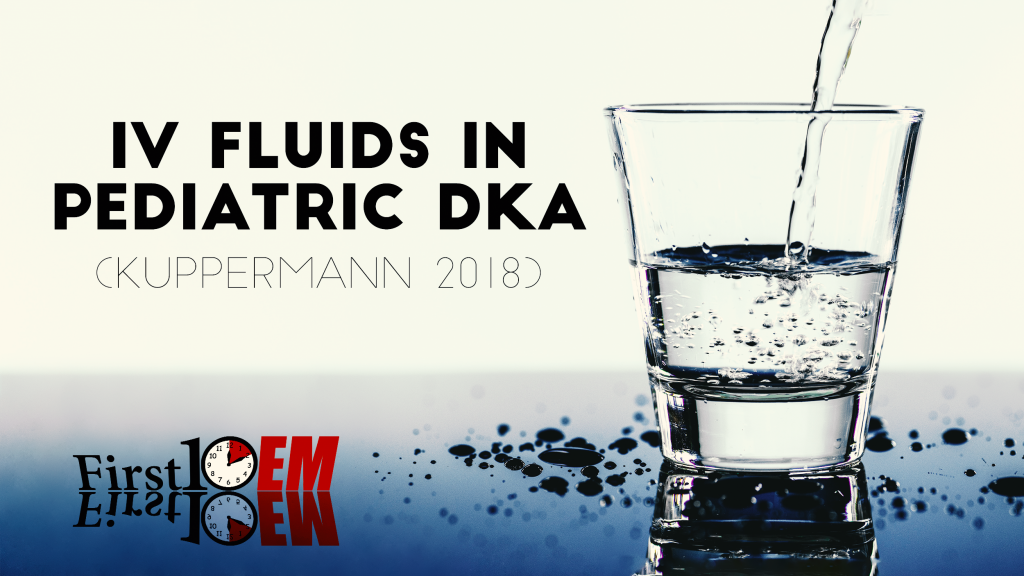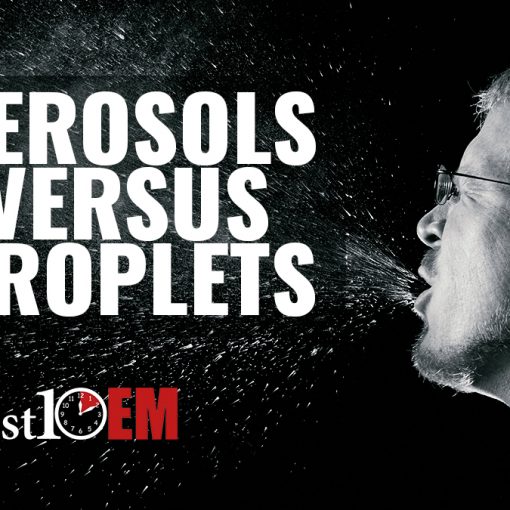Some children with diabetic ketoacidosis (DKA) develop cerebral edema and have bad neurologic outcomes. Unfortunately, when this happens, fingers are frequently pointed at emergency physicians for our overzealous use of intravenous fluids. Children are not little adults, we are told, and cannot tolerate the same volumes of fluids. Or perhaps it is the use of hypotonic fluids. Either way, we are given very strong recommendations to avoid “aggressive” IV fluids, and to avoid hypotonic fluids. (TREKK 2014; Dunger 2004) However, the evidence base for these recommendations is very weak, relying entirely on observational data. (Hom 2008) This observational data indicates an association, but that does not translate to causation. Children receiving more fluids tend to be sicker and more likely to develop cerebral edema in the first place, meaning the association with fluids could be entirely based on confounding. A case control study done in 2001 found no association with volume of fluid resuscitation, but instead with acidosis and renal failure (markers of disease severity). (Glaser 2001) To date, there has been a lot of conjecture, but not a lot of answers. Finally, we have a large, randomized trial to guide our management…
The paper
Kuppermann N, Ghetti S, Schunk JE, et al. Clinical Trial of Fluid Infusion Rates for Pediatric Diabetic Ketoacidosis. The New England journal of medicine. 2018; 378(24):2275-2287. PMID: 29897851
The Methods
This is a multicenter randomized controlled trial, with a 2×2 design.
Patients: Children (0-18 years old) with a diagnosis of DKA (glucose >300mg/dL or 16.7mmol/L and a pH <7.25 or a bicarbonate <15mmol/L).
- Exclusions: Disorders that could affect mental status or neurocognitive testing, concurrent alcohol or narcotic use, head trauma, pregnancy, factors for which physicians determined a specific fluid and electrolyte therapy was necessary. After the second year of the trial, patients with a GCS less than 11 were also excluded.
Groups:
- Fast rehydration with 0.45% sodium chloride
- Fast rehydration with 0.9% sodium chloride
- Slow rehydration with 0.45% sodium chloride
- Slow rehydration with 0.9% sodium chloride
Fast rehydration assumed a fluid deficit of 10% of the patient’s body weight. They gave an initial bolus of 10 mL/kg, followed by a second 10 mL/kg bolus at the physician’s discretion, and then ran an infusion for half the remaining deficit (plus maintenance) for the next 12 hours. The remaining deficit was repleted by 36 hours.
Slow hydration assumed a fluid deficit of 5% of the patient’s body weight. An initial bolus of 10 mL/kg was given, but no additional boluses were allowed. The remaining fluid deficit was then repleted over 48 hours.
Outcome: The primary outcome was deterioration of the neurologic status in the first 24 hours.
- Secondary outcomes included: short term memory during DKA treatment, clinically apparent brain injury, and short term memory, contextual memory, and IQ 2 to 6 months after the episode of diabetic ketoacidosis.
All centers were in the United States. Other than the rate of fluid resuscitation, all patients received the same treatment, following a standardized DKA treatment protocol.
The Results
1255 children were randomized, but because 132 had 2 episodes of DKA, 1389 episodes of DKA are assessed.
There was no difference between the groups in terms of decline of neurologic function. The overall rate of decline below a GCS of 14 was 3.5%, with 1.6% being treated with hyperosmolar therapy, and 0.9% having clinically apparent brain injury.

None of the secondary outcomes show statistically significant differences. The point estimates actually all look worse in the slow fluid groups, but none of the differences were statistically significant.
There were protocol violations in about 8% of both groups, but the per-protocol analysis also didn’t reveal any difference.
My thoughts
This is clearly the best study we have on the topic to date, but unfortunately no study is perfect. Both groups in this trial actually received relatively conservative fluid resuscitation, because that is the current standard in pediatric resuscitation. It isn’t clear how these results would compare to the 20-30 mL/kg boluses we frequently use in adult practice. Personally, I doubt larger boluses are harmful, but we should be careful with our interpretation of this study. It does not say that we can start flooding children with IV fluids.
I don’t think the inclusion criteria for this study were great. I have a big problem with any pediatric study that lumps together 17 year olds and 6 month olds. When it comes to cerebral edema, it is the youngest children that we are most worried about. Lumping them together with patients who are essentially adults doesn’t make a lot of sense, and could mask a real difference in the younger patients.
The results here could also be affected by selection bias. Patients were excluded if their treating physicians “determined a specific fluid and electrolyte therapy was necessary”. 289 children (about 10% of the total trial population) were excluded for this reason.
Finally, although this is an incredibly large trial (considering the topic), there were still only 12 patients with clinically apparent brain injury. Therefore, we are left with very large confidence intervals.
Before this study, I thought that it was probably a myth that fluid choice impacted cerebral edema in pediatric DKA. This study seems to support that belief. (I try to be mindful of how my current opinions might influence my critical appraisals, but we all have prejudices from which we cannot escape). Ultimately, the outcomes look pretty similar no matter what group you were assigned to. This study doesn’t prove anyone wrong. It doesn’t mean that if you are currently using a very restrictive IV fluid strategy you must change your practice. But hopefully it will stop the huge amount of dogmatic criticism of emergency physicians’ fluid choices that I have seen over the years.
Bottom line
For now, this is the definitive study on the topic. It doesn’t look like fluid choice impacts the occurrence of cerebral edema or brain injury in pediatric DKA.
Other FOAMed
Sweet and Salty – fluids in DKA on Don’t Forget the Bubbles
The Rate of Resuscitation in Pediatric DKA on Emergency Medicine Literature of Note
References
Dunger DB, Sperling MA, Acerini CL, Bohn DJ, Daneman D, Danne TP, et al. European Society for Paediatric Endocrinology/Lawson Wilkins Pediatric Endocrine Society consensus statement on diabetic ketoacidosis in children and adolescents. Pediatrics. 2004 Feb;113(2):e133–40. [PubMed]
Glaser N, Barnett P, McCaslin I, et al. Risk Factors for Cerebral Edema in Children with Diabetic Ketoacidosis N Engl J Med. 2001; 344(4):264-269.
Hom J, Sinert R. Evidence-based emergency medicine/critically appraised topic. Is fluid therapy associated with cerebral edema in children with diabetic ketoacidosis? Annals of emergency medicine. 2008; 52(1):69-75.e1. [pubmed]
TREKK. (2014). Bottom Line Recommendations: Diabetic Ketoacidosis. [Found here]
Morgenstern, J. IV fluids do not cause cerebral edema in pediatric DKA (Kuppermann 2018), First10EM,
July 5, 2018. Available at:
https://doi.org/10.51684/FIRS.6073






5 thoughts on “IV fluids do not cause cerebral edema in pediatric DKA (Kuppermann 2018)”
The question I want to post, is what to do with the uncompensated shock kid who is GCS 3, SBP in the 60’s, HR in the 180’s, super vasoconstricted, dry like a potato chip with a glucose of 66 mmol/L (~1200 mg/dl). This kid was the sickest DKA I’ve ever seen and he looked like was about to arrest. The consultant pediatrician jumped out of her skin when she saw I gave a 20 ml/kg bolus of NS. My priority was perfusion! This kid had no intravascular volume left, and even after the 20 cc/kg his vitals didn’t change. She called me incompetent and dangerous because of the “large volume” I had given.
Besides getting my feelings hurt (not really), I was surprised she ordered pitiful amount of fluid infusion while this kid was in shock and remained in shock for many hours. Unfortunately, this kid didn’t do well, arrested the next morning and could not be resuscitated.
I remember the mantra: Treat shock! The longer a shock state continues, multi organ disfunction gets closer and closer. This kid was not perfusing his brain, heart and kidneys, and he stayed like that for hours even in the hospital. He had no catecholamines left and all his functional reserve was gone. The team had such a fear of “causing” CE by volume expansion, that allowed this kid to die still hypovolemic
There is some evidence showing that kids who “develop” CE, ALREADY HAVE CE when we start treatment. The hypothesis is that kids brains have higher oxygen demand and develop global ischemia from hypo perfusion a lot faster than adult brains. Also, the profound vasoconstriction with high catecholamines and acidosis, together with blood-brain barrier dysfunction lead to inflammatory changes causing CE. Here: https://www.nejm.org/doi/full/10.1056/NEJM200101253440404
Another study (18 kids only) showed MRI was worse early in the severe DKA than after treatment: http://pediatrics.aappublications.org/content/131/1/e73?sso=1&sso_redirect_count=1&nfstatus=401&nftoken=00000000-0000-0000-0000-000000000000&nfstatusdescription=ERROR%3a+No+local+token
And finally… Canadians (yes, great Canadians) found the highest features associated with CE were high BUN, low CO2, and bicarb treatment, suggesting that severe dehydration/hypovolemia and acidosis are important risk factors. https://www.jpeds.com/article/S0022-3476(04)01216-8/fulltext
So… Going back to my question. What do I do for the shocky, Glasgow of 3, severe DKA kid? Do I correct hypovolemia? In my simple way of thinking, delaying intravascular volume repletion to 36 hrs, is delaying brain perfusion for 36 hr. There is now enough evidence to suggest that its not the treatment, but the ischemia and blood-brain barrier dysfunction what causes CE and by delaying adequate brain perfusion we may be putting these kids at risk. I think a trial for rapid intravascular volume correction over shorter period of time vs 36 hrs with brain imaging in all kids early, is warranted.
OK.. rant over.
That sounds like a really difficult case. I am sorry.
The quick answer is: if the child is in shock, I will continue to bolus until the shock resolves. I tend to use 10mL/kg boluses so I can reassess between each one, but would have no problem giving 4 or 5 boluses rapidly in a very sick child with DKA.
As far as the evidence goes, I don’t think the evidence was ever convincing that fluids were the cause of cerebral edema. This is the best trial that exists, and there is no difference. Unfortunately, the volumes of fluid here are very low, and the patients don’t really represent the patient you are describing. We still can’t be sure whether very large fluid boluses are safe in these very sick DKA patients. That being said, if I am worried about shock, I will rapidly fluid resuscitate until I am comfortable that the child is perfusing their vital organs, and then let the inpatient team decide what to do with the fluids after that.
I am with you Justin… This issue of CE very well might be one of the biggest myths is medicine. Someone somewhere had a child with DKA and had a bad outcome, the CT showed edema and IVF were thought to be cause. That person told the next one and so on. Now we are stuck with this fear that so far, has no solid base to exist.